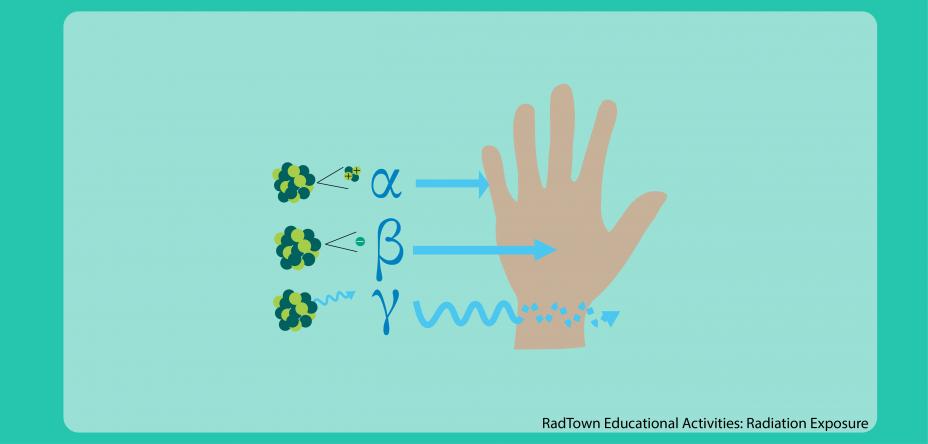RadTown Radiation Exposure Activity 5: Radiation Health Effects
Ionizing radiation has enough energy to affect the atoms in living cells and damage their genetic material (DNA). Fortunately, the cells in our bodies are extremely efficient at repairing this damage. However, if the damage is not repaired correctly, a cell may die or eventually become cancerous. This activity directs students to research different ways we may be exposed to radiation and encourages them to share their findings with their class. This activity is intended for middle and high school students.
- Objectives
- Next Generation Science Standards
- Materials and Resources
- Time
- Vocabulary
- Directions
- Common Core State Standards
Objectives
Students will:
- Identify sources of radiation exposure.
- Research the uses and health effects.
- Assess the benefits and risks of radiation exposure.
Next Generation Science Standards
The concepts in this activity can be used to support the following science standards:
- PS4. Waves and Electromagnetic Radiation
Materials and Resources
- Radiation Exposure: Teacher Background Information
- Vocabulary Materials
- Student computers with Internet access (or provide print versions for students)
- Paper or poster board and colored pencils, pens, markers or other art supplies or student computers
Time
45-60 minutes, not including optional activities or extensions.
Vocabulary
- Alpha particles
- Beta particles
- Direct exposure
- Gamma rays
- Ingestion
- Inhalation
- Ionizing radiation
- Man-made radiation
- Natural (background) radiation
- Radiation
- Radiation exposure
- X-rays
Directions
- Start with a vocabulary activity if students are not familiar with radiation and the terms used in this activity, or provide students with the terms and definitions.
- Ask students why people often fear radiation. They fear radiation because it can damage cells and our DNA. Ironically, radiation can cause cancer as well as be used to diagnose and treat diseases, including cancer.
- Explain that radiation is a part of our natural world and it’s all around us. Our bodies are adapted to handle some radiation exposure. Each of our bodies, and the cells within our bodies, reacts differently to radiation exposure. The health effects may also depend on the type of radiation, the exposure pathway, the radiation’s energy and the total amount of radiation absorbed.
- Ask students to name several sources of natural (background) and man-made ionizing radiation (e.g., radon, the sun, x-rays and nuclear power plants).
- Explain that each radiation source gives off different types of ionizing radiation. The major types of ionizing radiation include alpha particles, beta particles, gamma rays and x-rays. We also may be exposed to radiation through different exposure pathways. The three main exposure pathways are direct exposure, inhalation (through breathing) and ingestion (through eating). For example, we are exposed to the sun through direct exposure and radon is a gas that we might inhale.
- Ask students to hypothesize whether the different types of ionizing radiation produce the same health effects and how the health effects may differ by exposure pathway. For example, radiation in tobacco may be inhaled and increase a person’s risk of developing lung cancer, exposure to the sun can lead to sunburns and skin cancer, and ingested radioactive materials could impact the thyroid gland, the stomach or kidneys. Exposure to radiation can also serve as a health benefit. For example, nuclear medicine may be ingested to help diagnose and treat a sick individual. In moderation, the sun serves as a source of vitamin D.
- Direct students to select and review common radioactive elements or the radiation found in tobacco. NOTE: If student computers are not accessible, the information can be printed and shared with students.
- Direct students to research a radiation source. Have students identify potential health risks and benefits for each exposure pathway (direct exposure, inhalation or ingestion) and the targeted organs or systems. Students can collect information to present in the form of a (visual or electronic) presentation including a representation of the human body and the targeted organs or systems.
- Have students share their findings.
- Conclude by having students discuss:
- Any identified relationships between radiation types, radiation health effects (whether perceived as a risk or benefit) and exposure pathways.
- When the benefits of particular radioactive elements may outweigh the risks.
- Situations in which they may have control over their exposure or be able to limit their exposure, such as avoiding cigarettes and secondhand smoke or reducing any elevated radon levels in their home.
- How the activity has changed or supported their perceptions or concerns about radiation exposure.
Common Core State Standards (CCSS)
The concepts in the Radiation Health Effects activity align with the following standards:
- CCSS English Language Arts Standards for Literacy in History/Social Studies, Science, & Technical Subjects:
- CCSS.ELA-Literacy.SL.6-12.2 Comprehension and Collaboration
- CCSS.ELA-Literacy.SL.6-12.4 Presentation of Knowledge and Ideas
- CCSS.ELA-Literacy.WHST.6-12.9 Research to Build and Present Knowledge

